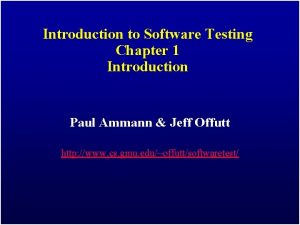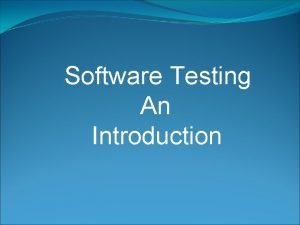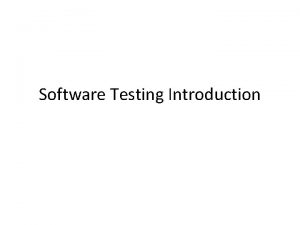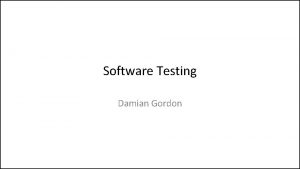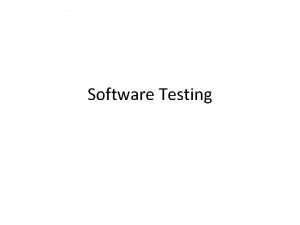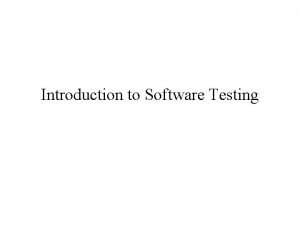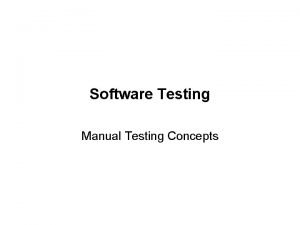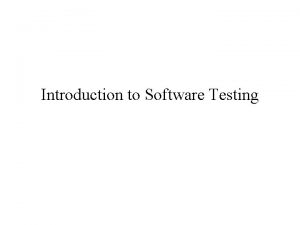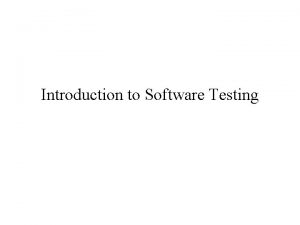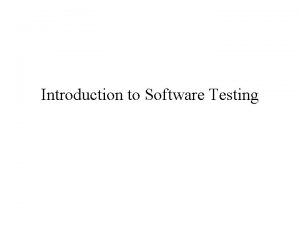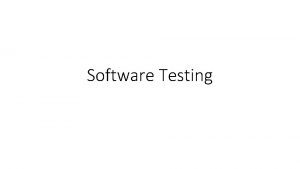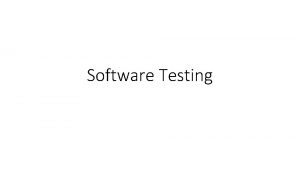Introduction to Software Testing Chapter 8 1 1












- Slides: 12

Introduction to Software Testing Chapter 8. 1. 1 Logic Coverage Paul Ammann & Jeff Offutt http: //www. cs. gmu. edu/~offutt/softwaret est/ This version modified for online presentation Spring 2020

Semantic Logic Criteria (8. 1) • Logical expressions can come from many sources – Decisions in programs – Decisions in UML activity graphs and finite state machines – Requirements, both formal and informal – SQL queries • Covering logic expressions is required by the US Federal Aviation Administration for safety critical software – Used by other transportation industries • Used by Electronc Arts (EA) game company – FIFA, Battlefield, … • Tests are intended to choose some subset of the total number of truth assignments to the Introduction to Software Testing, Edition 2 (Ch 8) © Ammann & Offutt 2

Logic Predicates and Clauses • A predicate is an expression that evaluates to a boolean value • Predicates can contain – boolean variables – non-boolean variables that contain >, <, ==, >=, <=, != – boolean function calls • Internal structure is created by logical operators – ¬ or ! – the negation operator – or & – the and operator – or | – the or operator – – the implication operator – or xor – the exclusive or operator – – the equivalence operator • A clause is a predicate with no logical operators Introduction to Software Testing, Edition 2 (Ch 8) © Ammann & Offutt 3

Example P = (a & (b | c)) P has three clauses: 1. a 2. b 3. c Most predicates have few clauses • • 88. 5% have 1 clause 9. 5% have 2 clauses 1. 35% have 3 clauses Only 0. 65% have 4 or more ! Introduction to Software Testing, Edition 2 (Ch 8) © Ammann & Offutt 4

Logic Coverage Criteria (8. 1. 1) • We use predicates in testing as follows : – Develop a model of the software as one or more predicates – Require tests to satisfy some combination of clauses Predicate Coverage (PC) : For each p in P, TR contains two requirements: p evaluates to true, and p evaluates to false. • PC: Each full predicate evaluates to true and false Clause Coverage (CC) : For each c in C, TR contains two (2 tests) requirements: c evaluates to true, and c evaluates to false. • CC: Each clause in each predicate evaluates to true and false (at least 2 tests per predicate Introduction to Software Testing, Edition 2 (Ch 8) © Ammann & Offutt 5

In-Class Exercise PC and CC coverage P = (a & (b | c)) Please work with as many partners as you can. Give predicate coverage (PC) and clause coverage (CC) abstract tests for our example predicate. “Abstract tests” include truth assignments for each clause, for example: a = true Introduction to Software Testing, Edition 2 (Ch 8) © Ammann & Offutt 6

In-Class Exercise—solution PC and CC coverage P = (a & (b | c)) PC: a=true, b=true, c=true a=f, b=f, c=f CC: a, !b, !c !a, b, c Any format is fine, the answers for CC are more Please work with ascompact many partners as you can. Give predicate coverage (PC) and clause coverage (CC) abstract tests for our example predicate. “Abstract tests” include truth assignments Introduction to Software Testing, Edition 2 (Ch 8) © Ammann & Offutt 7

Problems with PC and CC • PC does not fully exercise all the clauses, especially in the presence of short circuit evaluation • CC does not always ensure PC – That is, we can satisfy CC without causing the predicate to be both true and false – This is definitely not what we want ! • The simplest solution is to test all combinations … Introduction to Software Testing, Edition 2 (Ch 8) © Ammann & Offutt 8

Combinatorial Coverage (Co. C) • Co. C requires every possible combination • Sometimes called Multiple Condition Coverage (MCC) • Every possible combination of truth values – 2 N possibilities, where N is the number of clauses Combinatorial Coverage (Co. C) : For each p in P, TR has test requirements for the clauses in Cp to evaluate to each possible combination of truth values. Introduction to Software Testing, Edition 2 (Ch 8) © Ammann & Offutt 9

In-Class Exercise Co. C coverage P = (a & (b | c)) Please work with as many partners as you can. Give abstract tests to satisfy combinatorial coverage (Co. C) for our example predicate. Hint: There should be 8 Introduction to Software Testing, Edition 2 (Ch 8) © Ammann & Offutt 10

In-Class Exercise—solution Co. C coverage Co. C a=true, b=true, c=true a=f, b=t, c=f Please work with as many a !b c partners as you can. a !b !c !a b c Give abstract tests to satisfy !a b !c combinatorial coverage !a !b c (Co. C) for our example !a !b !c predicate. P = (a & (b | c)) Hint: There should be 8 Introduction to Software Testing, Edition 2 (Ch 8) © Ammann & Offutt 11

Combinatorial Coverage • This is simple, neat, clean, and comprehensive … • But can be expensive – Impractical for predicates with more than 3 or 4 clauses • The literature has lots of suggestions – some confusing • The general idea is simple: Test each clause independently from the other clauses • Getting the details right is hard • What exactly does “independently” mean ? • The book presents this idea as “making clauses active” … Introduction to Software Testing, Edition 2 (Ch 8) © Ammann & Offutt 12
 What is domain testing
What is domain testing Motivational overview in software testing
Motivational overview in software testing Du path testing
Du path testing Globalization testing
Globalization testing Cause effect graphing technique
Cause effect graphing technique Control structure testing in software engineering
Control structure testing in software engineering Decision table testing in software testing
Decision table testing in software testing Decision table technique
Decision table technique Extended decision table
Extended decision table Rigorous testing in software testing
Rigorous testing in software testing Testing blindness in software testing
Testing blindness in software testing Software domain examples
Software domain examples Introduction software testing
Introduction software testing












